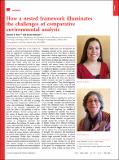| dc.contributor.author | Bors, Eleanor Kathleen | |
| dc.contributor.author | Solomon, Susan | |
| dc.date.accessioned | 2013-12-30T15:28:50Z | |
| dc.date.available | 2013-12-30T15:28:50Z | |
| dc.date.issued | 2013-05 | |
| dc.identifier.issn | 0027-8424 | |
| dc.identifier.issn | 1091-6490 | |
| dc.identifier.uri | http://hdl.handle.net/1721.1/83349 | |
| dc.description.abstract | Stratospheric ozone loss is on course to become a solved environmental problem, with all significant producing countries (including China and India) undertaking complete phase-outs of ozone-depleting substances. The universal concurrence and speed with which ozone loss has been addressed are sometimes heralded as signs that effective international agreements on other problems of the global commons are just around the corner. However, progress on many other issues has been strikingly limited. Is ozone the exception, rather than the rule, and if so why? Here we present one way to illuminate why some environmental problems are more tractable than others by consideration of a “nested” (vs. nonnested) framework. [Nested governance schemes are an established part of the common pool of resource literature (e.g., refs. 1 and 2), where use of the term “nesting” or “polycentricity” generally refers to the spatial scale of governance (e.g., grassroots to national); our focus here is broader.] We will refer to nesting as having three components: intellectual, societal, and institutional. Intellectual nesting refers to the academic communities that study the roots of the problem as well as possible solutions. Societal nesting refers to the sectors of human actors and activities that are associated with the problem. Institutional nesting describes the types of governance or management structures that could address the problem. We define a fully nested environmental problem as one for which the science of the problem is rooted within multiple, disparate disciplines, and for which the causes, impacts, and solutions are nested within different sectors of society and government. Within these definitions, we discuss marine biodiversity loss as an example of a deeply nested environmental problem, climate change as a mostly nested environmental problem, and ozone depletion as a much less-nested environmental problem. | en_US |
| dc.language.iso | en_US | |
| dc.publisher | National Academy of Sciences (U.S.) | en_US |
| dc.relation.isversionof | http://dx.doi.org/10.1073/pnas.1306240110 | en_US |
| dc.rights | Article is made available in accordance with the publisher's policy and may be subject to US copyright law. Please refer to the publisher's site for terms of use. | en_US |
| dc.source | PNAS | en_US |
| dc.title | How a nested framework illuminates the challenges of comparative environmental analysis | en_US |
| dc.type | Article | en_US |
| dc.identifier.citation | Bors, E. K., and S. Solomon. “How a nested framework illuminates the challenges of comparative environmental analysis.” Proceedings of the National Academy of Sciences 110, no. 19 (May 7, 2013): 7531-7532. | en_US |
| dc.contributor.department | Massachusetts Institute of Technology. Department of Biology | en_US |
| dc.contributor.department | Massachusetts Institute of Technology. Department of Chemistry | en_US |
| dc.contributor.department | Massachusetts Institute of Technology. Department of Earth, Atmospheric, and Planetary Sciences | en_US |
| dc.contributor.mitauthor | Bors, Eleanor Kathleen | en_US |
| dc.contributor.mitauthor | Solomon, Susan | en_US |
| dc.relation.journal | Proceedings of the National Academy of Sciences | en_US |
| dc.eprint.version | Final published version | en_US |
| dc.type.uri | http://purl.org/eprint/type/JournalArticle | en_US |
| eprint.status | http://purl.org/eprint/status/PeerReviewed | en_US |
| dspace.orderedauthors | Bors, E. K.; Solomon, S. | en_US |
| dc.identifier.orcid | https://orcid.org/0000-0002-2020-7581 | |
| dc.identifier.orcid | https://orcid.org/0000-0003-1751-1467 | |
| mit.license | PUBLISHER_POLICY | en_US |
| mit.metadata.status | Complete | |
